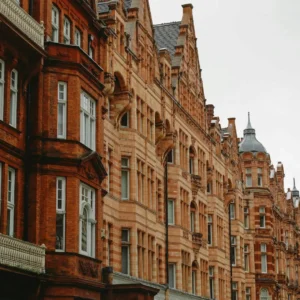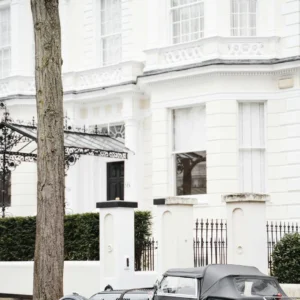Mayfair Architectural History and Its Surroundings
Mayfair, a prestigious area in the heart of London, is renowned for its timeless elegance and Mayfair architectural history. Steeped in history, Mayfair’s buildings reflect the changing tastes and influences of different periods. From the stately Georgian townhouses to the opulent modern developments, the architecture of Mayfair and its surrounding areas tells the story of a city that has grown and evolved over centuries. This article explores the fascinating history and development of Mayfair’s architecture. It also covers significant landmarks in nearby areas like Green Park and Hyde Park.
The Origins of Mayfair’s Architecture
 The architectural story of Mayfair begins in the early 18th century. At that time, Mayfair was mainly a rural area with open fields. It was not until the 1680s, when the area became part of the family estates of the 1st Earl of Mayfair, that it began to see major development. The aristocracy largely influenced the construction of Mayfair’s first buildings. They aimed to create a fashionable district reflecting their social status.
The architectural story of Mayfair begins in the early 18th century. At that time, Mayfair was mainly a rural area with open fields. It was not until the 1680s, when the area became part of the family estates of the 1st Earl of Mayfair, that it began to see major development. The aristocracy largely influenced the construction of Mayfair’s first buildings. They aimed to create a fashionable district reflecting their social status.
The Georgian period, in particular, marked a significant turning point for Mayfair’s architecture. Neoclassical designs became the defining feature of the area. Elegant, symmetrical facades and uniform row houses quickly replaced the rural landscape. These houses were built using high-quality materials such as brick, stone, and marble, reflecting the wealth of their owners.
Georgian Influences in Mayfair: Mayfair Architectural History
Mayfair’s Georgian architecture is perhaps the most iconic. Between 1720 and 1820, the area flourished with the construction of large, carefully planned terraces of houses. These houses were designed with clean, simple lines, large windows, and decorative details like cornices and columns. Many of the buildings still stand today, offering a glimpse into the opulent lifestyles of the era.
The most famous example of Georgian architecture in Mayfair is the grand, elegant townhouses that line streets like Grosvenor Square and Berkeley Square. These houses often feature large front doors, narrow windows, and symmetrical facades. Despite their grandeur, architects designed these buildings to feel harmonious with their surroundings, emphasising order and balance.
As Mayfair grew, the streets were lined with high-end shops, private clubs, and fashionable residences. The area’s architecture became a symbol of luxury and refinement, attracting both the aristocracy and wealthy individuals from across Europe. Leading architects of the time, including Robert Adam and John Nash, designed many of these buildings and left their mark on the area.
Victorian and Edwardian Architecture: Mayfair Architectural History
As London expanded in the 19th century, the architectural landscape of Mayfair began to change. The industrial revolution brought about new building materials and construction methods, allowing for more ornate and elaborate designs. During this time, the Victorian and Edwardian periods had a significant influence on the architectural development of Mayfair and its surroundings.
Victorian architecture in Mayfair is characterised by its intricate details, ornate brickwork, and large windows. These buildings were designed to reflect the new wealth of the industrial era. Many of the Victorian buildings in Mayfair have a more eclectic style, blending elements from Gothic Revival, Italianate, and Queen Anne designs. This period saw the rise of private clubs, such as the Reform Club, which still stand as impressive examples of Victorian architecture.
The Edwardian period followed, bringing a more refined, classical style to the area. Buildings constructed during this time were typically more restrained in their decoration but still featured luxurious materials, such as marble and granite. The grand buildings around Green Park, including the Ritz Hotel, showcase Edwardian architecture. They continue to define the area’s charm.
Modern Developments and Contemporary Architecture
While Mayfair’s historical architecture is its most celebrated feature, the area has not remained frozen in time. Over the last few decades, new developments have introduced a blend of modern and contemporary designs into the architectural landscape. High-rise buildings and sleek glass facades now sit alongside traditional Georgian structures, creating a fusion of old and new.
Some of the most striking modern buildings in Mayfair include the luxury residential blocks and commercial office spaces. Architects often design these buildings with cutting-edge technologies and eco-friendly materials, reflecting the area’s status as a hub for innovation and business. Despite their modernity, these structures blend seamlessly with traditional architecture, preserving the historic character of Mayfair.
The surrounding areas, including areas near Hyde Park, have also seen significant modern development. While these areas still retain much of their historic charm, new architecture continues to enhance the city’s skyline. In particular, the development of buildings like the One Hyde Park complex has brought a new level of luxury to the area, offering residents a modern lifestyle with stunning views of Hyde Park.
Significant Landmarks in Mayfair and Surrounding Areas
 Beyond the individual buildings, there are several landmarks in Mayfair and its neighbouring areas that hold great architectural and historical significance.
Beyond the individual buildings, there are several landmarks in Mayfair and its neighbouring areas that hold great architectural and historical significance.
Grosvenor Square
One of Mayfair’s most famous landmarks is Grosvenor Square, which has long been a symbol of the area’s wealth and influence. The square is home to some of the finest Georgian architecture in London. Its symmetrical houses reflect the high status of former residents. The square has undergone various changes over the years but remains an iconic part of Mayfair.
Hyde Park
Just to the south of Mayfair lies Hyde Park, one of London’s largest and most famous parks. Hyde Park was originally laid out in the 16th century, but its development during the 18th century, with the creation of key structures like the Serpentine Lake and the grand gates, brought a new architectural elegance to the area. Today, the park continues to be a defining feature of Mayfair’s surroundings.
Green Park
Green Park, located to the east of Mayfair, is another important landmark in the area. Though less formal than nearby Hyde Park, Green Park’s tranquil atmosphere and central location make it a popular spot for locals and visitors alike. Notable buildings, including Buckingham Palace, border the park. It offers a dramatic backdrop to the surrounding architecture.
Conclusion: Mayfair Architectural History
The architecture of Mayfair and its surrounding areas offers a rich historical narrative, telling the story of London’s growth from a rural district to one of the world’s most sophisticated and prestigious locations. From the Georgian elegance of its townhouses to the modern developments that now shape its skyline, Mayfair’s buildings represent a blend of the past and the present.